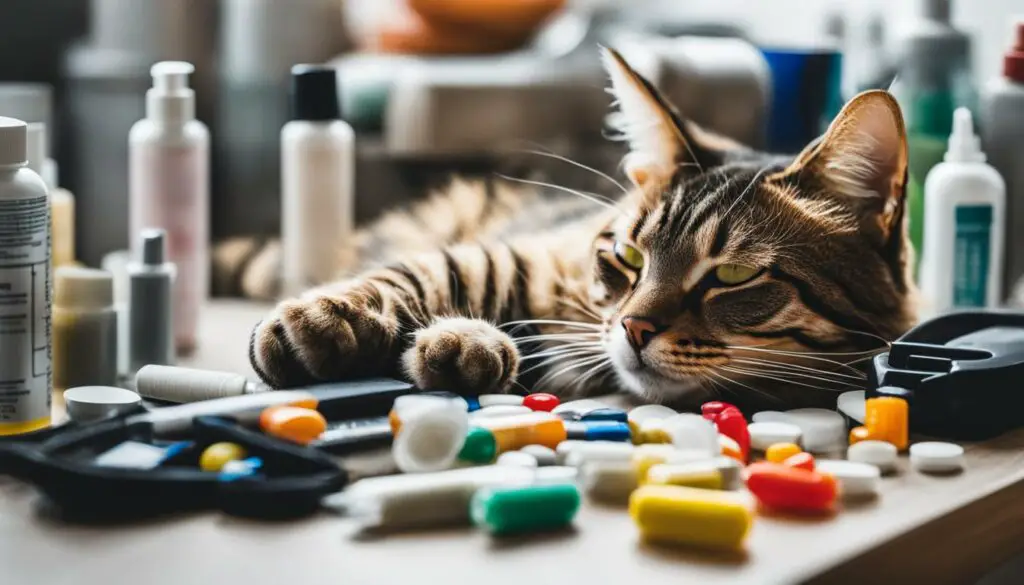As a cat owner, I understand the challenges of grooming a feline friend who becomes stressed or anxious during the process. That’s why finding the right over the counter cat sedative for grooming is crucial. With the help of a suitable sedative, you can make grooming a more comfortable and stress-free experience for your beloved cat.
Key Takeaways:
- Finding the right over the counter cat sedative can help ease your cat’s stress during grooming sessions.
- Cats may require sedation for grooming due to stress, fear, or anxiety.
- Recognizing signs of stress or fear in cats is essential for determining the need for sedation during grooming.
- There are various sedatives available for cats, both over the counter and prescription options.
- Consulting with a veterinarian is crucial for ensuring the safety and efficacy of any sedative or anxiety-reducing medication.
Why Do Cats Need Sedation for Grooming?
Cats may require sedation during grooming due to stress, fear, or anxiety. These emotions can manifest in various ways, including attempts to escape, aggression, or physical illness. Grooming can be a particularly stressful experience for cats, as it involves handling, restraint, and unfamiliar sensations like the sound and vibration of grooming tools. Sedatives can help calm cats and make grooming sessions more manageable by reducing anxiety and discomfort.
Some cats have a natural aversion to being handled or touched, while others may have had negative experiences with grooming in the past. Cats with a history of trauma, abuse, or neglect are more likely to exhibit fear or aggression during grooming. Additionally, certain medical conditions or sensitivities, such as arthritis or skin disorders, can make grooming painful or uncomfortable for cats, leading to anxiety and resistance.
By administering a sedative before grooming, cat owners can help their feline companions relax and tolerate the necessary grooming procedures. Sedatives work by affecting the central nervous system, producing a calming effect and reducing anxiety. This can make the grooming process easier for both the cat and the groomer, resulting in a more positive and stress-free experience.
| Sedation Benefits for Cats: | Sedation Considerations: |
|---|---|
|
|
Cats should always be assessed individually to determine the most appropriate sedative and dosage. Consulting with a veterinarian is essential to ensure the cat’s safety and well-being during grooming procedures.
Signs of Stress or Fear in Cats
Cats have unique ways of expressing their stress or fear, and it’s crucial for cat owners to recognize these signs in order to provide appropriate care and support. Here are some common symptoms that may indicate stress or fear in cats:
- Making themselves appear small by crouching or hiding
- Flattening their ears against their head
- Raised hair along their back and tail
- Dilated pupils
- Excessive meowing or vocalization
- Attempts to escape or hide
- Loss of appetite or decreased food intake
- Signs of aggression, such as growling, hissing, or scratching
- Changes in behavior, such as increased irritability or lethargy
- Urinating outside the litter box
These symptoms can vary in intensity and duration depending on the individual cat and the underlying cause of their stress or fear. It’s essential to observe your cat’s behavior closely and consult with a veterinarian if you notice any of these signs.
Recognizing the signs of stress or fear in cats is the first step in helping them feel more comfortable and secure.
It’s important to note that these symptoms can also be indicative of other health issues, so it’s crucial to rule out any potential medical causes before attributing them solely to stress or fear. A thorough examination by a veterinarian can help determine the underlying cause and guide the appropriate course of action.
| Signs of Stress or Fear in Cats | Possible Causes |
|---|---|
| Making themselves appear small by crouching or hiding | Anxiety, fear, or feeling threatened |
| Flattening their ears against their head | Aggression, discomfort, or fear |
| Raised hair along their back and tail | Stress, fear, or agitation |
| Dilated pupils | Fear, excitement, or arousal |
| Excessive meowing or vocalization | Attention-seeking, discomfort, or fear |
| Attempts to escape or hide | Feeling threatened, fear, or anxiety |
| Loss of appetite or decreased food intake | Anxiety, stress, or underlying medical condition |
| Signs of aggression, such as growling, hissing, or scratching | Fear, discomfort, or territoriality |
| Changes in behavior, such as increased irritability or lethargy | Stress, fear, underlying medical condition, or discomfort |
| Urinating outside the litter box | Stress, fear, anxiety, or underlying medical condition |
Recognizing the signs of stress or fear in cats is the first step in helping them feel more comfortable and secure. By addressing the underlying causes and providing appropriate care, cat owners can promote their feline companions’ well-being and create a harmonious living environment.
How Cat Anxiety is Treated
When it comes to treating cat anxiety, a multi-faceted approach is often necessary. This can include behavior modification techniques, environmental changes, natural remedies, supplements, and sedatives or other medications. Each cat is unique, so it’s important to find the right combination of treatments that works best for their individual needs.
Behavior Modification
Behavior modification techniques can help cats feel more comfortable and safe in their environment. This can include positive reinforcement training, desensitization, and counter-conditioning exercises. By gradually exposing the cat to the triggers that cause anxiety and rewarding calm behavior, it’s possible to reduce their anxiety levels over time.
Environmental Changes
Creating a calm and stress-free environment is essential for cats with anxiety. This can involve providing hiding spaces, vertical spaces for climbing, and interactive toys to keep them mentally stimulated. Additionally, products like Feliway, which release calming pheromones, can help create a soothing atmosphere.
Natural Remedies and Supplements
Natural remedies and supplements can play a role in reducing cat anxiety. L-theanine, an amino acid found in green tea, has been shown to have calming effects on cats. Other supplements such as chamomile, valerian root, and CBD oil may also help reduce anxiety. However, it’s important to consult with a veterinarian before using any natural remedies or supplements to ensure they are safe and appropriate for your cat.
Sedatives and Medications
In some cases, sedatives or anti-anxiety medications may be necessary to provide additional relief for cats with severe anxiety. These medications can help reduce anxiety levels and make grooming sessions or other stressful events more manageable. Commonly prescribed medications include trazodone, fluoxetine, and clomipramine. It’s important to work closely with a veterinarian to determine the most appropriate medication and dosage for your cat.
By combining these various treatment approaches, it’s possible to help cats manage their anxiety and improve their overall well-being. Remember, it’s important to consult with a veterinarian to develop a tailored treatment plan that meets your cat’s specific needs.
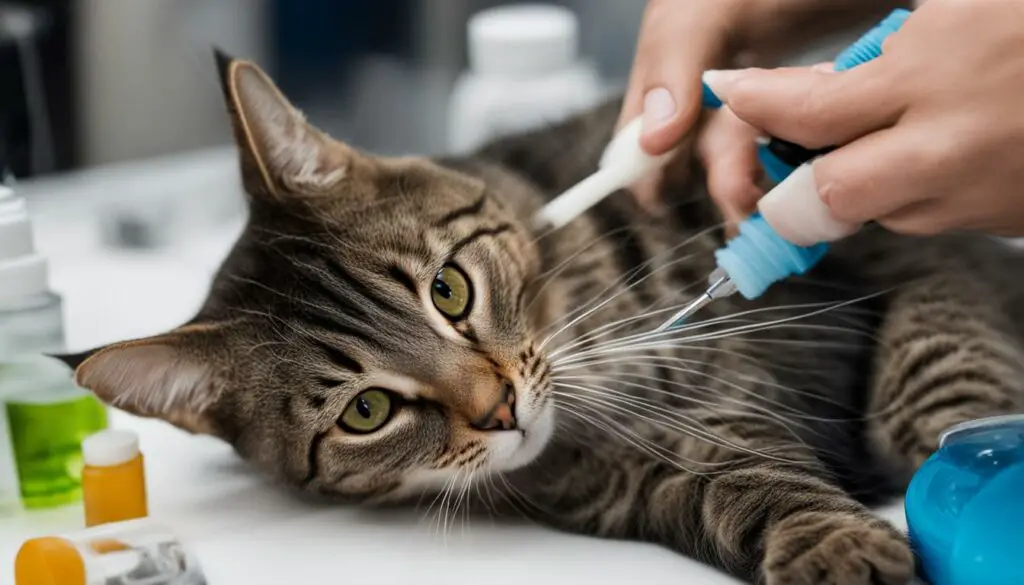
Common Sedatives Used for Cats
When it comes to finding the best cat sedative for grooming, there are several options to consider. Each cat may respond differently to these medications, so it’s important to work closely with your veterinarian to find the most suitable sedative for your feline friend. Here are some common sedatives used for cats during grooming:
| Sedative | Benefits | Potential Side Effects |
|---|---|---|
| Benadryl (Diphenhydramine) | Provides sedation and can help with mild anxiety | Drowsiness, dry mouth, urinary retention |
| Acepromazine | Offers sedation and anxiety relief | Low blood pressure, hypothermia, decreased heart rate |
| Gabapentin | Often used for short-term events like grooming or vet visits | Drowsiness, ataxia, increased appetite |
| Trazodone | Provides sedation and anxiety relief for various situations | Sedation, dizziness, gastrointestinal upset |
| Alprazolam (Xanax) | Helps with short-term anxiety during grooming or other stressful events | Sedation, incoordination, increased appetite |
These sedatives can help calm cats and make grooming sessions more manageable by reducing anxiety and discomfort. However, it’s important to note that each cat may react differently to these medications, and it’s crucial to follow your veterinarian’s guidance on dosage and administration. Additionally, it’s essential to monitor your cat for any adverse reactions and discontinue use if any serious side effects occur.
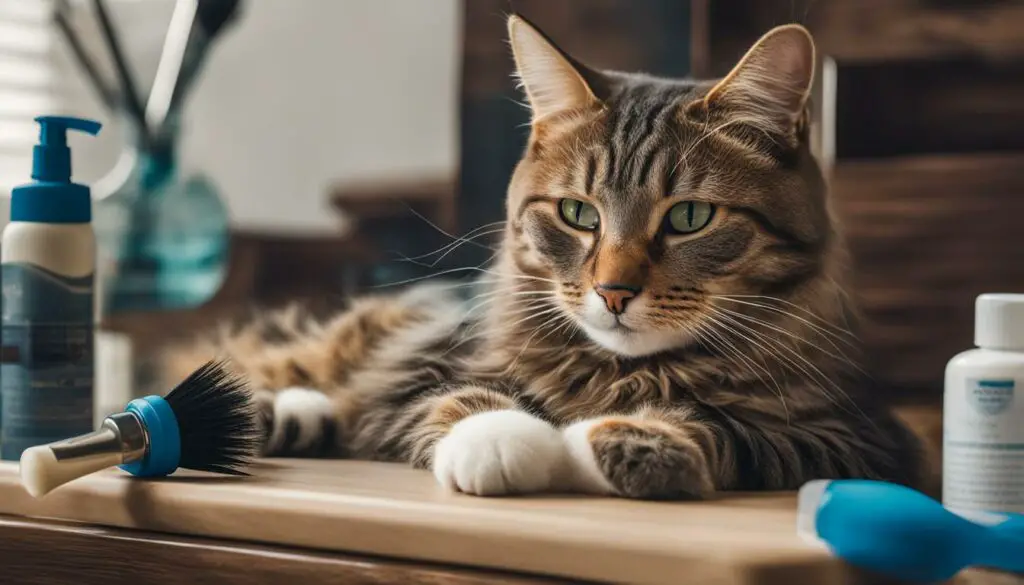
Long-term Anxiety Medications for Cats
While over the counter (OTC) sedatives can be effective for short-term anxiety relief, some cats may require long-term medications to manage chronic anxiety. Long-term anxiety medications for cats are typically prescribed by veterinarians and can help provide consistent relief for cats with ongoing anxiety issues. These medications are often used in cases where behavior modification techniques, natural remedies, or short-term sedatives have not adequately addressed the cat’s anxiety.
Two common types of long-term anxiety medications for cats are selective serotonin reuptake inhibitors (SSRIs) and tricyclic antidepressants. SSRIs work by increasing the levels of serotonin in the brain, which helps regulate mood and anxiety. Popular SSRIs for cats include fluoxetine (Prozac) and sertraline (Zoloft). Tricyclic antidepressants, such as amitriptyline, work by blocking the reuptake of certain neurotransmitters, resulting in an increased concentration of these chemicals in the brain.
| Long-term Anxiety Medications for Cats | Common Brands |
|---|---|
| Selective Serotonin Reuptake Inhibitors (SSRIs) | Fluoxetine (Prozac), Sertraline (Zoloft) |
| Tricyclic Antidepressants | Amitriptyline |
It’s important to note that these medications should only be given under the guidance of a veterinarian and after a thorough evaluation of the cat’s medical history and current condition. Dosages may vary depending on the individual cat, so it’s crucial to follow the veterinarian’s instructions precisely.
Long-term anxiety medications for cats can help manage chronic anxiety and reduce the likelihood of anxiety flare-ups. These medications are often used for cats with stress-related conditions like interstitial cystitis, as anxiety can worsen symptoms in these cases. By providing ongoing anxiety relief, long-term medications can help improve the overall well-being and quality of life for cats with chronic anxiety.
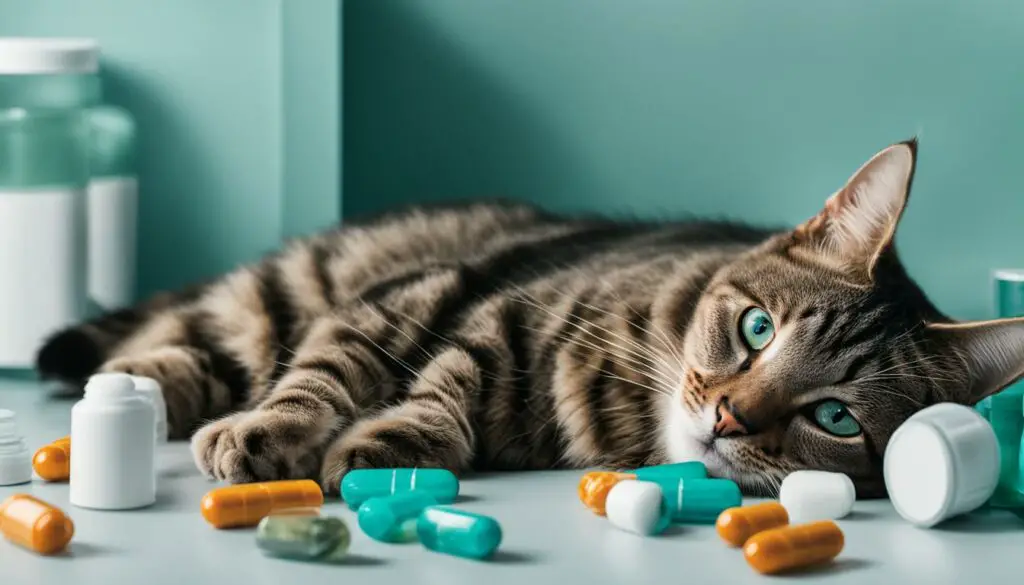
References
- “Long-term Medication.” Behavior Treatment for Anxiety in Cats | VCA Animal Hospital, https://vcahospitals.com/know-your-pet/behavior-treatment-for-anxiety-in-cats.
- Treating Anxiety in Cats and Dogs.” Pet Health Network, https://www.pethealthnetwork.com/cat-health/cat-diseases-conditions-a-z/treating-anxiety-cats-and-dogs.
Natural Remedies for Cat Anxiety
Cats experiencing anxiety can benefit from a variety of natural remedies that help promote a sense of calm and relaxation. These remedies can be used alongside or as an alternative to pharmaceutical options, providing a holistic approach to managing cat anxiety.
The following are some natural remedies that can help alleviate cat anxiety:
- Behavior Modification Techniques: Implementing behavior modification techniques, such as creating a safe and enriching environment, establishing a routine, and providing interactive toys, can help reduce anxiety in cats over time.
- Herbal Treatments: Herbal treatments like chamomile, valerian root, and lavender can have calming effects on cats. These can be administered in the form of essential oils, dried herbs, or natural supplements specifically formulated for cats.
- Pheromone Products: Pheromone-based products like Feliway release synthetic calming pheromones that mimic the scent cats produce when they feel safe and secure. These products can be used in diffusers, sprays, or collars.
- Thundershirts: Thundershirts are snug-fitting garments that provide gentle pressure to help cats feel secure and reduce anxiety. These can be particularly useful during grooming or other stressful situations.
- Supplements: Supplements such as L-theanine or Zylkene can help promote relaxation and reduce anxiety in cats. These supplements are available in various forms, including powders, capsules, or chews.
“Natural remedies can be a valuable tool in managing cat anxiety, providing a gentle and holistic approach. It’s important to remember that what works for one cat may not work for another, so it may take some trial and error to find the most effective solution. Consulting with a veterinarian is always recommended to ensure the safety and appropriateness of any natural remedy.”
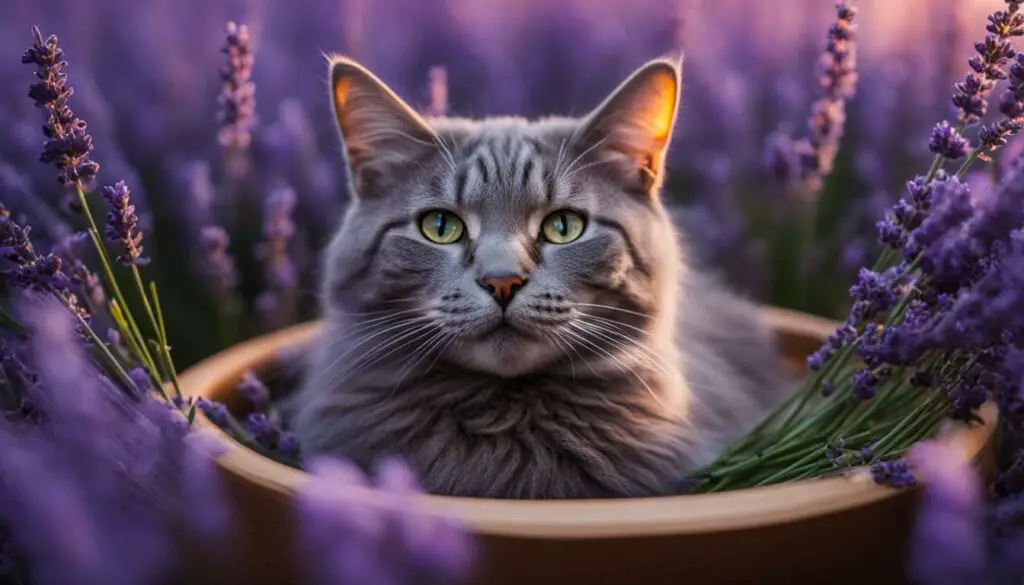
Table: Natural Remedies for Cat Anxiety
| Remedy | Benefits |
|---|---|
| Behavior Modification Techniques | Promote long-term anxiety reduction |
| Herbal Treatments | Calming effects on cats |
| Pheromone Products | Recreate a safe and secure environment |
| Thundershirts | Provide gentle pressure for anxiety relief |
| Supplements | Promote relaxation and reduce anxiety |
When using natural remedies for cat anxiety, it’s important to consult with a veterinarian to ensure their safety and appropriateness for your cat. The veterinarian can provide guidance on the proper dosage, application method, and potential interactions with other medications or underlying health conditions. By combining natural remedies with a supportive and loving environment, you can help your cat feel calmer and more at ease.
Injectable Sedation for Cats
When oral sedatives don’t provide sufficient sedation for cats during grooming or veterinary procedures, injectable sedation may be necessary. Injectable sedatives are stronger and typically administered by trained veterinary professionals to ensure the safety and wellbeing of the cat.
There are several commonly used injectable sedatives for cats, each with its own advantages and considerations:
| Sedative | Benefits | Considerations |
|---|---|---|
| Medetomidine and dexmedetomidine | Strong sedative effect | Should be used with caution in cats with certain medical conditions |
| Acepromazine | Provides sedation and anxiety relief | May not be suitable for cats with liver or heart conditions |
| Combination of butorphanol, methadone, hydromorphone, and more | Offers strong sedation | Should only be administered under close veterinary supervision |
It’s important to note that injectable sedation should only be used when necessary and under the guidance of a veterinarian. The dosage and administration of injectable sedatives require professional expertise to ensure the safety of the cat.
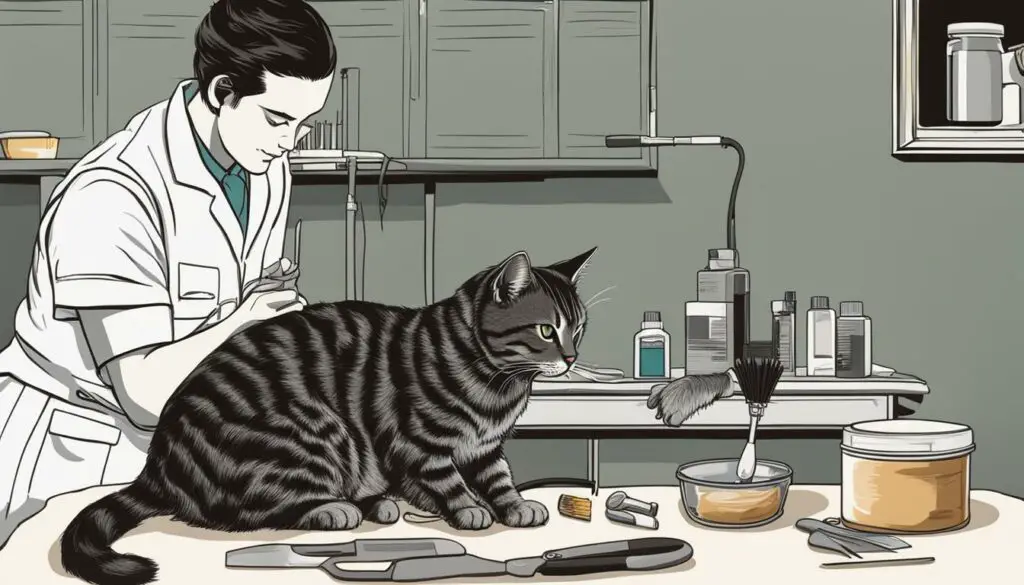
“Injectable sedation is a valuable tool in managing cat stress and anxiety during grooming or veterinary procedures. The use of injectable sedatives should always be done under the supervision of a veterinarian to ensure the proper dosage and administration for each individual cat.” – Dr. Emily Johnson, DVM
Tips for Administering Oral Sedatives to Cats
Administering oral sedatives to cats can be a challenging task, but with the right techniques and approach, it can become easier and less stressful for both you and your feline friend. Here are some tips to help you successfully give oral sedatives to your cat:
1. Choose the Right Time and Environment
Find a calm and quiet environment where your cat feels comfortable. Avoid distractions and loud noises that could make the process more stressful. Choose a time when your cat is relaxed and not too anxious, such as after a meal or during a quiet part of the day.
2. Use Pill Pockets or Compounded Medications
Pill pockets are small, soft treats that have a hollow center where you can hide the oral sedative. Many cats find these treats tasty and are more likely to eat them without realizing there is medication inside. Alternatively, you can ask your veterinarian to compound the medication into a flavored liquid or gel form that is easier to administer.
3. Practice Proper Restraint Techniques
Restraint techniques are essential to ensure the safe administration of oral sedatives. Gently hold your cat’s head from the sides, using your thumb and forefinger to open the mouth. Tilt your cat’s head slightly upward to encourage swallowing. It may be helpful to have another person assist you by holding your cat’s body securely.
4. Use a Cat Piller or Syringe for Small Doses
If you’re unable to use pill pockets or compounded medications, a cat piller or syringe can be useful tools for administering small doses of oral sedatives. These devices help you safely place the medication at the back of your cat’s throat for easy swallowing. Be gentle and avoid causing any discomfort or anxiety during the process.
| Sedative Name | Dosage Form | Pros | Cons |
|---|---|---|---|
| Benadryl (Diphenhydramine) | Tablet, Liquid | Can be purchased without a prescription, mild sedative effect | May cause drowsiness, should be used with caution in cats with certain medical conditions |
| Acepromazine | Tablet, Injection | Provides sedation and anxiety relief | Can cause low blood pressure, should be used with caution in cats with certain medical conditions |
| Gabapentin | Capsule, Liquid | Often used for short-term events like grooming or vet visits | May cause sedation and coordination problems |
| Trazodone | Tablet, Liquid | Offers sedation and anxiety relief for various situations | May cause drowsiness, gastrointestinal upset |
Table: Commonly used oral sedatives for cats during grooming
Safety Precautions for Cat Sedation During Grooming
Grooming can be a stressful experience for cats, and sedation can help alleviate their anxiety. However, it’s important to prioritize the safety and well-being of your feline friend when using sedatives. Here are some safety precautions to keep in mind when sedating your cat for grooming:
- Consult with a veterinarian: Before administering any sedative to your cat, consult with a veterinarian to ensure that it is safe for your cat’s specific needs. They can provide guidance on the appropriate sedative, dosage, and administration techniques.
- Follow dosage instructions: It’s crucial to follow the dosage instructions provided by the veterinarian. Never exceed the recommended dose, as this can be dangerous for your cat’s health.
- Monitor for adverse reactions: Keep a close eye on your cat after administering the sedative. Watch for any signs of adverse reactions or side effects, such as excessive sedation, difficulty breathing, or allergic reactions. If you notice any concerning symptoms, contact your veterinarian immediately.
- Discontinue use if necessary: If your cat experiences any serious reactions or adverse effects to the sedative, discontinue use and notify your veterinarian. They can recommend alternative options or adjustments to ensure your cat’s safety.
- Consider underlying health conditions: Cats with certain underlying health conditions may be more susceptible to adverse effects from sedatives. Make sure to inform your veterinarian about any pre-existing conditions your cat may have before using a sedative.
- Avoid sedation without supervision: Sedating a cat for grooming should always be done under the supervision of a veterinarian. They have the knowledge and expertise to ensure the sedation process is safe and effective.
By following these safety precautions, you can help ensure a safe and comfortable grooming experience for your cat. Remember, the well-being of your cat should always be the top priority.
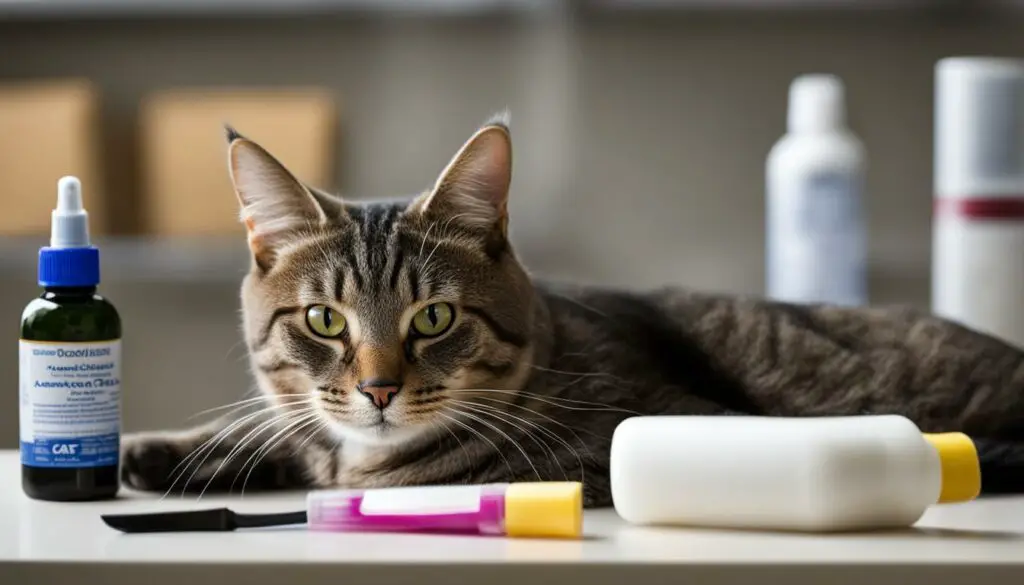
Expert Tip:
“Always consult a veterinarian before using any sedatives for your cat. They can provide personalized advice and recommendations based on your cat’s specific needs and health conditions.”
Non-Sedative Techniques for Calming Cats during Grooming
Grooming can be a stressful experience for cats, but sedation is not always the only solution. There are non-sedative techniques that can help calm cats and create a more positive grooming experience. Here are some effective strategies:
1. Create a Quiet and Comfortable Environment
Make sure the grooming area is quiet and free from distractions. Choose a room where your cat feels safe and secure. Using soft lighting and playing calming music can also help create a relaxing atmosphere.
2. Practice Gentle Handling Techniques
Approach your cat slowly and gently during grooming. Use soft strokes and avoid any sudden movements or rough handling. Pay attention to your cat’s body language and give them breaks if they appear tense or stressed.
3. Provide Positive Reinforcement and Treats
Reward your cat with praise, treats, or favorite toys during and after grooming sessions. This positive reinforcement helps create positive associations with grooming and can make your cat more willing to cooperate in the future.
Remember, each cat is unique, so it may take time to find the right combination of techniques that works best for your furry friend. Patience, consistency, and a gentle approach are key to successfully calming your cat during grooming without the need for sedatives. With these non-sedative techniques, you can help make grooming a more pleasant experience for both you and your cat.
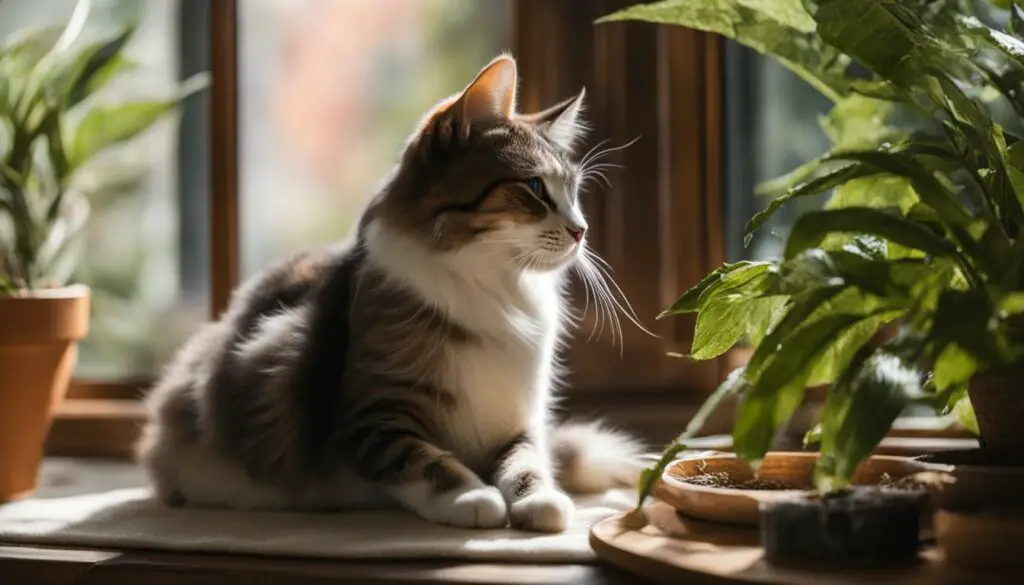
Understanding the Importance of Grooming for Cats
Grooming plays a crucial role in maintaining the health and well-being of cats. It goes beyond just keeping their fur clean and looking good. Regular grooming is essential for several reasons:
- Prevents matting and hairballs: Cats are known for their grooming habits, but sometimes they need a little help. Regular brushing removes loose hair and prevents it from forming mats, which can be uncomfortable and lead to skin problems. It also reduces the likelihood of hairballs, a common issue for cats.
- Keeps the skin healthy: Grooming helps to distribute the natural oils in a cat’s coat, keeping the skin moisturized and preventing dryness or irritation. It also allows for the early detection of any skin issues, such as rashes or parasites.
- Improves circulation: Brushing stimulates the blood flow to the skin, promoting a healthy coat and overall well-being.
- Promotes bonding: Grooming sessions can be a great opportunity for bonding between cats and their owners. It provides a chance for gentle touch and positive interaction, strengthening the bond between the two.
“Regular grooming helps keep cats comfortable, healthy, and happy.”
While some cats may not initially enjoy the grooming process, with the right techniques and approach, it can become a more enjoyable experience for both cats and their owners. Whether you choose to use sedatives or opt for non-sedative calming methods, the ultimate goal is to create a calm and comfortable environment for your feline friend.
By recognizing the importance of grooming and taking the necessary steps to make it a positive experience, you can ensure that your cat stays clean, healthy, and happy.

Choosing the Right Cat Sedative for Grooming
When it comes to choosing a cat sedative for grooming, it’s important to consider your cat’s specific needs and consult with a veterinarian. Not all sedatives are created equal, and what works for one cat may not be effective for another. By working closely with a professional, you can ensure that you find the best sedative option for your furry friend.
There are various factors to consider when selecting a cat sedative. The severity of your cat’s anxiety, any underlying health conditions, and the specific grooming procedure that will be performed all play a role in determining the most appropriate sedative. Your veterinarian will take these factors into account and provide guidance on the dosage and administration of the sedative.
It’s important to note that there are both over the counter (OTC) and prescription options for cat sedatives. OTC sedatives typically have milder calming effects and may be suitable for cats with mild anxiety. On the other hand, prescription sedatives are stronger and may be necessary for cats with more severe anxiety or specific medical conditions. Your veterinarian will help you determine which option is best for your cat’s individual needs.
| Sedative | Effectiveness | Administration |
|---|---|---|
| Benadryl | Mild | Oral |
| Acepromazine | Effective | Oral |
| Gabapentin | Short-term | Oral |
| Trazodone | Effective | Oral |
| Alprazolam (Xanax) | Short-term | Oral |
Remember, each cat is unique, and what works for one may not work for another, so it’s important to tailor the approach to your cat’s individual needs.
By choosing the right cat sedative for grooming and working closely with your veterinarian, you can help alleviate stress and anxiety in your cat during grooming sessions. Creating a calm and comfortable environment is essential for a positive grooming experience for both you and your feline friend.
Over the Counter Cat Sedatives vs. Prescription Sedatives
When it comes to finding the right sedative for your cat’s grooming needs, you have two main options: over the counter (OTC) sedatives and prescription sedatives. Both types can help alleviate stress and anxiety in cats, but there are some important differences to consider.
OTC Cat Sedatives
OTC cat sedatives are typically milder and more readily available without a prescription. They are designed to provide mild calming effects and can be suitable for cats with mild anxiety or discomfort during grooming. These sedatives often contain natural ingredients like herbs or amino acids that promote relaxation.
While OTC sedatives can be a convenient option, they may not be strong enough to effectively manage severe anxiety or specific medical conditions. It’s important to carefully read the instructions and follow the recommended dosage to ensure your cat’s safety and well-being.
Prescription Cat Sedatives
Prescription sedatives, on the other hand, are stronger and require a veterinarian’s prescription. These sedatives are typically used for cats with more severe anxiety or specific medical conditions that require a higher level of sedation. Prescription sedatives may include medications such as gabapentin, trazodone, or alprazolam. Your veterinarian will evaluate your cat’s individual needs and prescribe the most suitable sedative.
One advantage of prescription sedatives is that they can be tailored to your cat’s specific requirements. Your veterinarian will consider factors such as your cat’s overall health, grooming procedure, and anxiety level to determine the appropriate sedative and dosage. They can also provide guidance on how to administer the sedative safely and effectively.
| OTC Cat Sedatives | Prescription Cat Sedatives |
|---|---|
| Milder calming effects | Stronger sedation |
| Readily available without prescription | Requires a veterinarian’s prescription |
| Suitable for cats with mild anxiety | Used for cats with severe anxiety or specific medical conditions |
| May contain natural ingredients | May include medications like gabapentin, trazodone, or alprazolam |
Ultimately, the choice between OTC and prescription sedatives depends on your cat’s individual needs and the recommendation of your veterinarian. They will consider your cat’s anxiety level, overall health, and specific grooming procedure to determine the most appropriate sedative. Whether you opt for an OTC or prescription sedative, always follow the recommended dosage and consult with your veterinarian for guidance.
Conclusion
In conclusion, finding the best over the counter cat sedative for grooming can greatly benefit your feline friend. Whether you choose prescription sedatives or opt for non-sedative techniques, the ultimate goal is to create a calming and comfortable environment for your cat during grooming sessions.
Consulting with a veterinarian is crucial in determining the most appropriate sedative or anxiety-reducing medication for your cat’s specific needs. They can provide guidance on dosage, administration, and potential interactions with other medications or underlying health conditions.
Remember, each cat is unique, and what works for one may not work for another. It may take some trial and error to find the most effective solution for your cat’s anxiety during grooming. Whether you choose sedatives, natural remedies, or a combination of approaches, always prioritize the safety and well-being of your furry companion.
With the right sedative or non-sedative techniques in place, grooming can become a less stressful and more enjoyable experience for both you and your cat, ensuring that their coat stays clean, their skin remains healthy, and any potential health issues are caught early on.
FAQ
Why do cats need sedation for grooming?
Cats may require sedation for grooming due to stress, fear, or anxiety. Sedatives can help calm cats and make grooming sessions more manageable by reducing anxiety and discomfort.
What are the signs of stress or fear in cats?
Common signs of stress or fear in cats include making themselves appear small, flattened ears, raised hair, dilated pupils, excessive meowing, attempts to escape or hide, loss of appetite, signs of aggression, behavior changes, and urinating outside the litter box.
How is cat anxiety treated?
Cat anxiety can be treated through a combination of behavior modification, environmental changes, natural remedies, supplements, and sedatives or other medications. Behavior modification techniques help cats feel more comfortable, while environmental changes and natural remedies provide additional support. Sedatives or anxiety-reducing medications may be necessary for some cats.
What are some common sedatives used for cats?
Common sedatives used for cats during grooming include Benadryl, Acepromazine, Gabapentin, Trazodone, and Alprazolam (Xanax). Each cat may respond differently to these medications, so it’s important to work with a veterinarian to find the best option.
Are there long-term anxiety medications for cats?
Yes, selective serotonin reuptake inhibitors (SSRIs) and tricyclic antidepressants can be used as long-term anxiety medications for cats. Fluoxetine and amitriptyline are popular options.
Are there natural remedies for cat anxiety?
Yes, there are natural remedies that can help alleviate cat anxiety, such as behavior modification techniques, supplements like L-theanine or Zylkene, pheromone products like Feliway, body wraps like Thundershirts, and herbal treatments like Rescue Remedy or catnip.
What are injectable sedatives used for in cats?
Injectable sedatives are typically used for cats during veterinary procedures or when oral medications do not provide sufficient sedation. These sedatives should only be administered by trained veterinary professionals.
How can I administer oral sedatives to my cat?
Administering oral sedatives to cats can be challenging. Techniques such as using pill pockets, compounding medications into flavored forms, or using a cat piller can help facilitate the process. It’s important to follow the dosage instructions provided by the veterinarian and give the sedative at the appropriate time before the grooming session or other stressful event.
Are there any precautions to take when using cat sedatives?
Yes, it’s important to follow the dosage instructions provided by your veterinarian and never exceed the recommended dose. Monitor your cat for any adverse reactions or side effects, and discontinue use if any serious reactions occur. Consult with a veterinarian before using any sedatives, especially if your cat has underlying health conditions or is on other medications.
Are there non-sedative techniques for calming cats during grooming?
Yes, there are non-sedative techniques that can help calm cats during grooming, such as providing a quiet and comfortable environment, using gentle handling techniques, providing breaks during the grooming process, and using positive reinforcement and treats to reward calm behavior.
Why is grooming important for cats?
Grooming is important for cats as it helps keep their coat clean, removes loose hair and mats, prevents skin problems, and allows for the early detection of any health issues.
How do I choose the right cat sedative for grooming?
It’s important to consider the specific needs of your cat and consult with a veterinarian when choosing a cat sedative for grooming. Factors to consider include the severity of your cat’s anxiety, any underlying health conditions, and the specific grooming procedure that will be performed.
What is the difference between over the counter cat sedatives and prescription sedatives?
Over the counter (OTC) sedatives typically have milder calming effects and may be suitable for cats with mild anxiety. Prescription sedatives are stronger and may be necessary for cats with more severe anxiety or specific medical conditions.
Source Links
- https://cats.com/cat-sedatives
- https://bondvet.com/b/cat-sedative
- https://www.greatpetcare.com/cat-supplements/6-vet-approved-cat-sedatives-for-travel/

